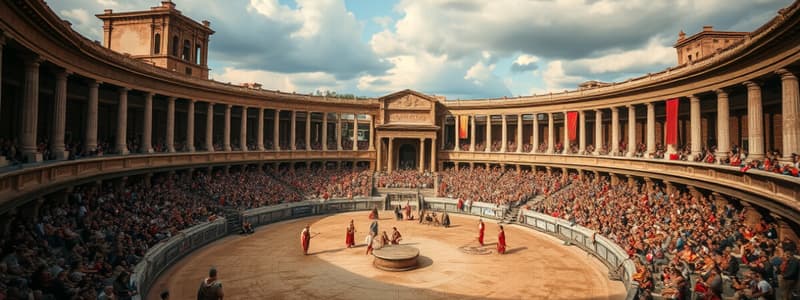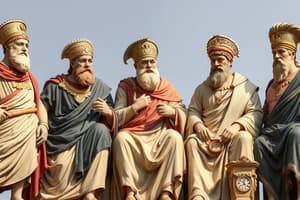Podcast
Questions and Answers
Who was Julius [blank]?
Who was Julius [blank]?
Caesar
Match the following types of gladiators with their characteristics:
Match the following types of gladiators with their characteristics:
Murmillo = Heavily armored gladiator with a large shield Retiarius = Lightly armored gladiator with a net Thracian = Gladiator with a small shield and a sword Secutor = Gladiator with a large shield and a sword
The Roman Empire was founded in 509 BC.
The Roman Empire was founded in 509 BC.
False (B)
Study Notes
Ancient Rome
Roman Empire
- Foundation and Duration: Founded in 27 BC when Augustus became the first emperor; lasted until the fall of the Western Roman Empire in AD 476.
- Geography: At its height, the empire encompassed parts of Europe, North Africa, and the Middle East.
- Government: Transitioned from a Republic (509-27 BC) to an autocratic empire; significant emperors include Augustus, Nero, and Trajan.
- Society: Highly stratified; citizens enjoyed rights, while non-citizens and slaves had limited rights.
- Economy: Based on agriculture, trade, and slavery; extensive road networks facilitated trade.
- Culture and Contributions: Notable achievements in architecture (Colosseum, aqueducts), law (Roman law principles), and literature (Virgil, Ovid).
Gladiators and Entertainment
- Gladiatorial Games: Originated as funeral rites; evolved into public spectacles in arenas.
- Types of Gladiators: Various classes (e.g., Murmillo, Retiarius); trained fighters, often slaves or prisoners of war.
- Colosseum: Major venue for gladiatorial contests; could hold 50,000-80,000 spectators.
- Events: Included gladiator battles, animal hunts (venationes), and executions; often used for political propaganda.
- Popularity: Games were a major part of Roman culture; served to distract the populace (bread and circuses).
- Decline: Gladiatorial games gradually faded with the rise of Christianity and the moral opposition to violence, culminating in their eventual ban in the 5th century AD.
Roman Empire
- Foundation and Duration: Established in 27 BC with Augustus as the first emperor; Western Roman Empire ended in AD 476.
- Geography: At its peak, the empire spanned Europe, North Africa, and parts of the Middle East, showcasing extensive territorial reach.
- Government: Shifted from a Republic (509-27 BC) to an autocratic system; key emperors included Augustus, known for reforming governance, Nero, famous for tyranny, and Trajan, who expanded the empire.
- Society: Social hierarchy prominent; citizens had legal rights, whereas non-citizens and slaves were subjected to restrictions.
- Economy: Predominantly agrarian with significant reliance on trade and slavery; developed an extensive road network to enhance commerce.
- Culture and Contributions: Major developments in architecture (e.g., Colosseum, aqueducts), establishment of Roman law concepts, and influential literature by authors like Virgil and Ovid.
Gladiators and Entertainment
- Gladiatorial Games: Evolved from funeral rites into large public spectacles hosted in arenas, reflecting social and political dynamics.
- Types of Gladiators: Featured various types, such as Murmillo and Retiarius, often recruited from enslaved individuals or prisoners of war who were rigorously trained.
- Colosseum: A monumental venue for gladiatorial events, capable of accommodating 50,000 to 80,000 spectators, symbolizing Roman engineering prowess.
- Events: Included diverse entertainments, such as gladiator combat, animal hunts (venationes), and public executions, frequently serving as tools for political messaging.
- Popularity: Gladiatorial games were central to Roman entertainment culture, epitomizing the concept of "bread and circuses" to appease the masses.
- Decline: The popularity of games declined with the spread of Christianity and growing moral opposition to violent spectacles, leading to their prohibition in the 5th century AD.
Studying That Suits You
Use AI to generate personalized quizzes and flashcards to suit your learning preferences.
Description
Explore the history of the Roman Empire, from its foundation in 27 BC to its fall in AD 476. Delve into the geography, government, society, economy, and cultural contributions of this influential empire, as well as the significance of gladiatorial games in Roman entertainment.




